Review: The 2025 Porsche Cayenne GTS Prioritizes Engagement Over Speed
The performance gaps across the Cayenne lineup have never been smaller. Spend some time piloting a well-optioned S, and the last thing you’ll feel is that it’s lacking in speed or handling. And while the range-topping $205,795 Turbo GT will happily tackle a twisty back road like a sports car, it sets itself apart not just with its speed but by engaging its driver with a thrilling experience.
Where does the 2025 Porsche Cayenne GTS Coupe I’m driving this week fit in? Well, given that it employs the same twin-turbocharged 4.0-liter V8 as both the S and the Turbo GT, it won’t surprise you to learn that its straight-line performance is astonishing. Yet, like the range-topper, the GTS distinguishes itself by pairing that performance with an engaging driving experience. It creates a sense of occasion that you won’t find in lower trim levels without also wearing a price tag that starts with a two.
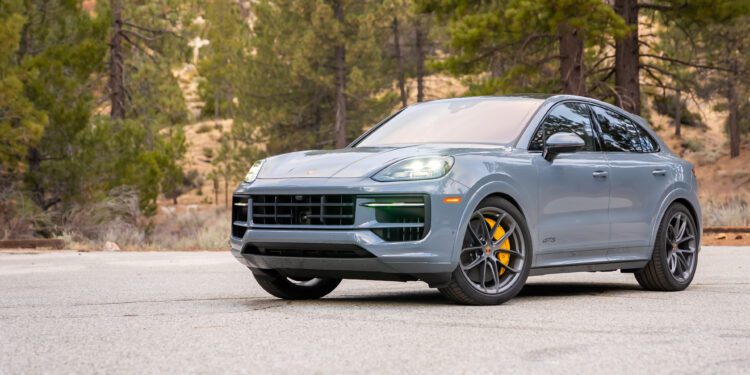
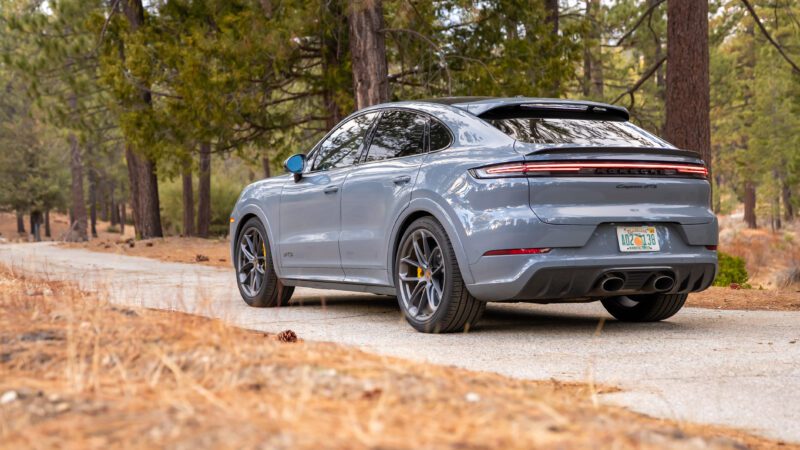
From a visual standpoint, one of the most significant advantages the Porsche Cayenne GTS has over the Turbo GT is that it’s available in both a standard SUV form and, like my tester, as a Coupe. Like previous iterations of this driver-focused trim, the GTS sports a unique front bumper adorned with larger air intakes. You’ll find black badges throughout its exterior, a standard set of 21-inch RS Spyder Design wheels, gloss black trim, and a Sport Exhaust System painted in a dark bronze finish.
If looking at the photos above gives you the impression that my tester looks a bit Turbo GT-lite, you’re not alone. Its optional exhaust with twin central exits helps it play the part, as do its $9,070 carbon-ceramic brakes and its yellow calipers. Its upgraded 22-in GT Design wheels are the same as you’ll find on the Turbo GT. At the same time, its $10,770 Premium Package Plus and Lightweight Sport Package add exterior extras such as a carbon fiber roof.
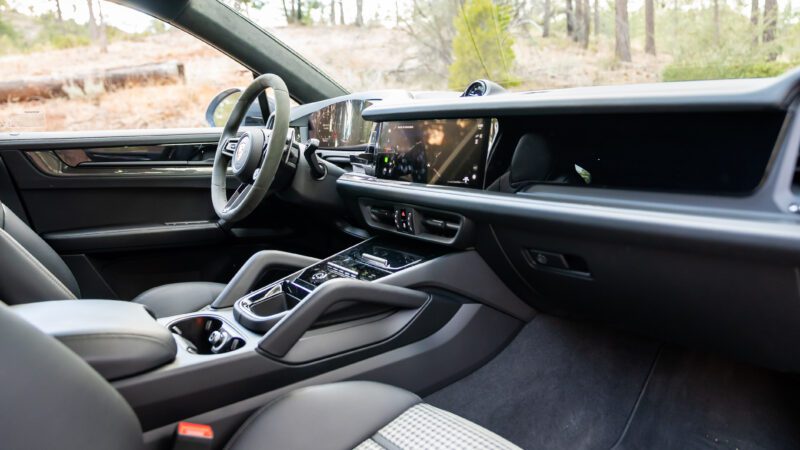
Yet despite this SUV’s many optional extras, it simultaneously makes a strong case for why ordering one in such a muted color combination, such as this tester’s $2,840 Arctic Grey, isn’t a great idea. What you end up with is a large family hauler that’s trying to come across as both sporty and toned-down. If you’re already buying a Cayenne with a snarling V8 and an active rear spoiler, why not go all in and let it shine with a brighter shade?
Inside, the GTS’ updates are more subtle. Its cabin features more surfaces finished in Race Tex, such as the GT Sport steering wheel, door cards, armrests, and roof liner. While its standard eight-way adjustable Sport seats feature the material, this tester opts for a more classic houndstooth pattern for its optional heated 18-way adjustable seats.
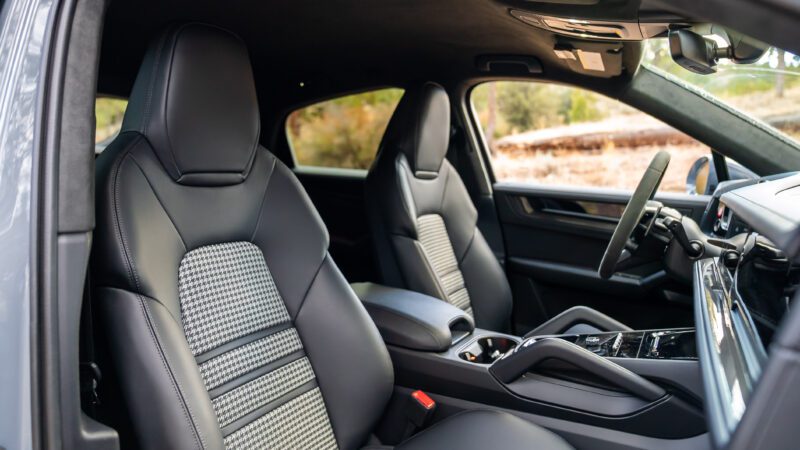
Peek under the GTS’ hood, and you’ll find the twin-turbo 4.0-liter V8 that’s become ubiquitous not just within the Porsche brand but across sister companies like Audi, Lamborghini, and Bentley. This iteration produces 493 horsepower and 487 pound-feet of torque, representing a 40 hp and 30 lb-ft increase over its successor. Still, that’s less than you get from a BMW X5 M Competition or an Audi RS Q8, two competitors that cost about the same as this well-optioned GTS Coupe, with a $159,615 as-tested price ($131,495 base).
Yet, as I alluded to earlier, the Porsche Cayenne GTS Coupe isn’t lacking when it comes to straight-line performance. By pairing its responsive V8 with a quick-shifting eight-speed automatic transmission, an all-wheel drive system, and traction control software borrowed from the Turbo GT, it’s rapid. Like practically all performance SUVs unveiled in the last decade, it kicks off with a strong wave of low-end torque that allows it to hit 60 mph in 4.2 seconds.
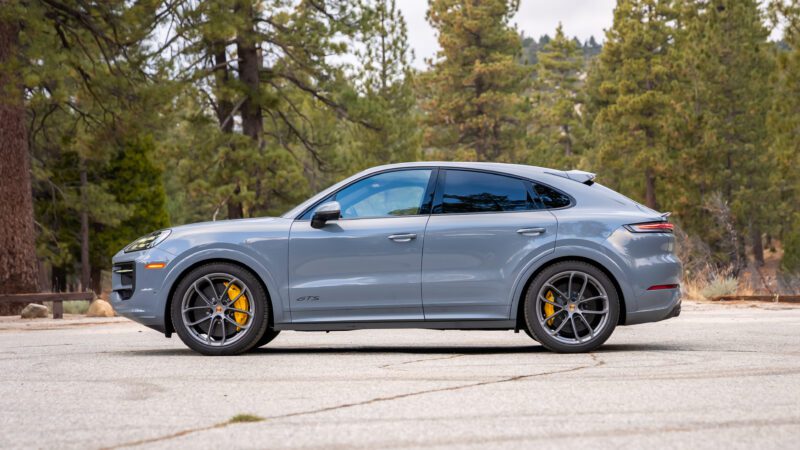
However, if you judge the GTS solely by its acceleration, you’ll miss the point. Recall the Cayenne S Coupe I mentioned in the intro? It also employs a nearly identical version of the GTS’ V8, and it’s comparatively swift.
To understand what makes the GTS special, you’ll have to point its nose towards a twisting back road because, like the many 911s, Boxsters, and Caymans that adopt that three-letter-moniker, this Cayenne is defined by its handling.
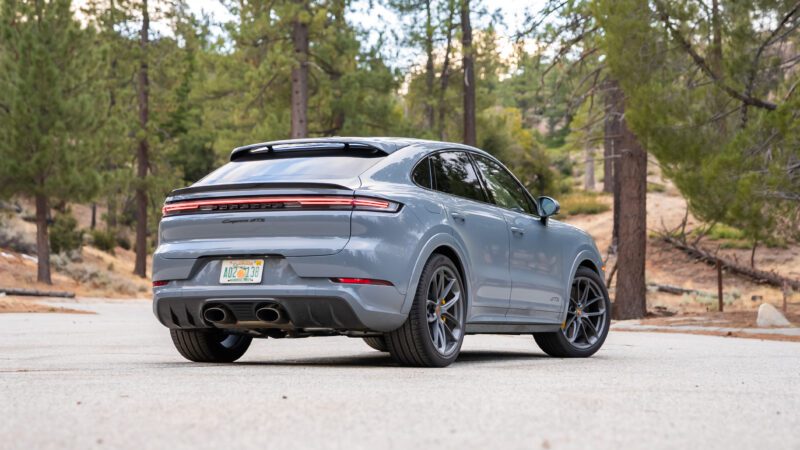
For this, the Porsche Cayenne GTS employs a trim-specific air suspension setup paired with the marque’s active suspension management and torque vectoring systems as standard. You can further bolster this SUV’s capabilities with the $3,580 Porsche Dynamic Chassis Control system like this tester and the Lightweight Sport Package, which drops the Coupe’s near 5,000-lb curb weight by up to 55 pounds.
By combining its adaptive air suspension system with a two-valve damper setup that allows the GTS to adjust rebound and compression independently, it’s able to firm its ride further in the top Sport+ setting while also being softer in Normal for a plush commuting experience. Up front, it borrows front-axle components from the Turbo GT to increase negative camber.
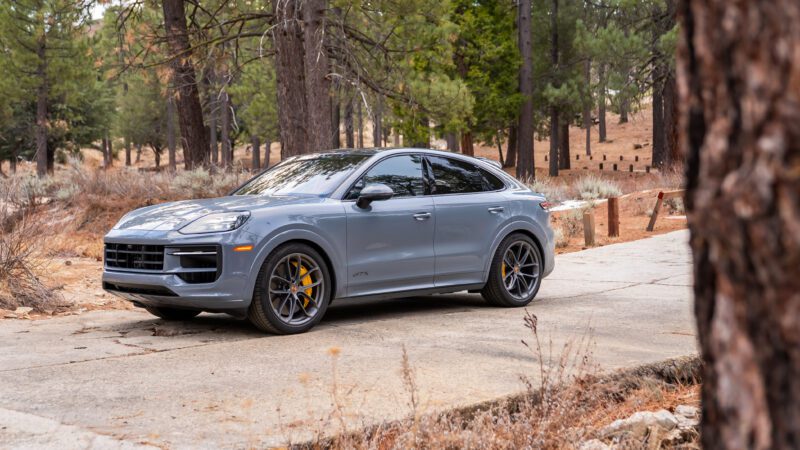
From the moment you turn onto a winding road, the effects of these targeted improvements are apparent. The Porsche Cayenne GTS is stable at higher speeds while retaining a fairly neutral balance in the bends. While its slightly lower ride height certainly helps, its adaptive suspension does most of the heavy lifting. This full-size SUV manages its weight remarkably well, and thanks to its large carbon-ceramic brakes, it has ample stopping power to keep it under control at the end of a straightaway.
However, what matters more is just how communicative the GTS is despite its weight and stature. Despite employing an electric power steering system, it transmits road feedback well while simultaneously picking up weight as you load up its front tires in a bend. Although its steering is quick, it’s not overly so like you’ll find in most modern M products, finding a nice balance between feeling responsive and natural.
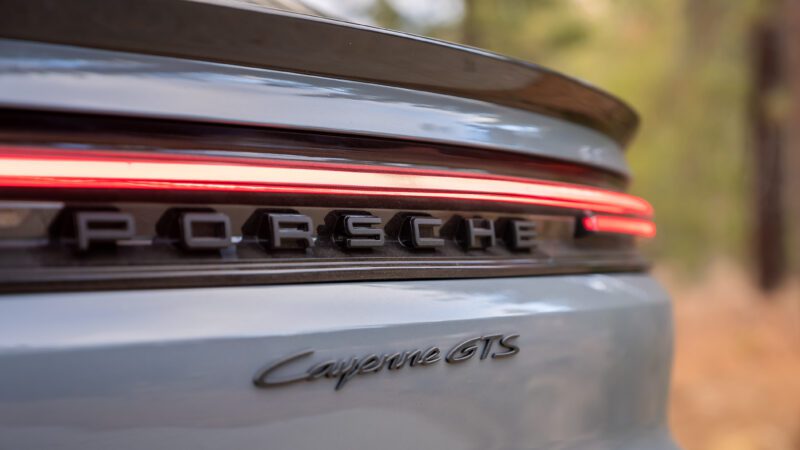
The result is an SUV that you buy not because of its performance statistics or how well it accelerates but because of how well it creates a sense of occasion through its handling. While the Porsche Cayenne GTS doesn’t look vastly different from other trim levels in stock form, its options list allows you to get quite close to the Turbo GT’s aesthetic without having to shell out the $205,795 it costs.
Instead, the $131,495 GTS Coupe ($159,615 as-tested) finds a sweet spot both within the Cayenne range and an industry flooded with fast family haulers by prioritizing driver engagement and augmenting it with speed.
Tags: Featured
Related Articles

Review: 2025 Mercedes-Benz GLS 580 4Matic
Eating Up Monotonous Miles The drive from Milwaukee to St….

2026 Aston Martin DBX S First Drive: The Best Super SUV Gets Even Better
Model year 2026 mar
Review: The 2025 Mercedes-Benz G550 Makes a Strong Case for Going Electric
by Gabriel Vega
in Reviews

The G-Class became an icon through consistency. Launched in 1979, the Geländewagen employs a similar formula to the one that has kept the Porsche 911 relevant for over seven decades. Rather than implementing revolutionary changes between generations, it leans on evolutionary ones. Although it has undoubtedly become more luxurious since the late 1970s, the G-Class centers around a particular aesthetic and driving experience, which, despite significant tweaks, still endures.
The 2025 Mercedes-Benz G550 I’m driving this week follows this formula almost perfectly. It’s the least expensive G-Class for the U.S. market, sitting below the all-electric G580 and the range-topping G63 by AMG. Still, with a $149,400 base price and this tester’s $181,000 out-the-door figure, it retains much of its predecessor’s look and feel but at an elevated price point.

Typically, this wouldn’t be an issue for a vehicle built exclusively to serve a group of well-off diehard fans. However, one major update introduced for the latest G550 is the substitution of its twin-turbocharged V8 with an electrified inline-six. This swap detracts from one of the G’s core tenets: its rumbly engine note. While the new powerplant is more powerful and efficient than the one it replaces, it’s also far quieter. It’s effectively non-existent in most driving scenarios. And if that’s the case, why not go all-in with the fully-electric G580?
From an aesthetic perspective, the new Mercedes-Benz G550 may be a case of the same, same, but different, but that’s a feature, not a fault. If you squint, you can tell that this off-roader features new front and rear bumpers, as well as a grille adorned with four horizontal louvers. In contrast, its predecessor had to make do with just three. Mercedes redesigned its air inlets to incorporate a square-off design with rounded edges, and its rear-view camera now sits above its license plate. That’s it.

For Geländewagen fans, this SUV retains its boxy shape, towering height, and overall aesthetic, which significantly contribute to its iconic status. Its door handles remain button-activated, making the same satisfying latching sound as they close. This tester features the optional $3,500 AMG Line package, which adds an upsized set of 20-inch wheels and flared wheel arches. This pairs nicely with the $3,250 Night Package that darkens its exterior trim. However, its highlight remains its $6,500 Manufaktur Deep Green paint, which, as you’ll soon learn, complements this SUV’s interior beautifully.
On the powertrain side, the latest Mercedes-Benz G550 introduces its most significant update: its turbocharged 3.0-liter inline-six engine. It develops 443 horsepower and 413 pound-feet of torque thanks in part to a 48-volt mild-hybrid system that can contribute up to 20 hp and 148 lb-ft for brief moments. This output goes to all four wheels via a nine-speed automatic transmission.
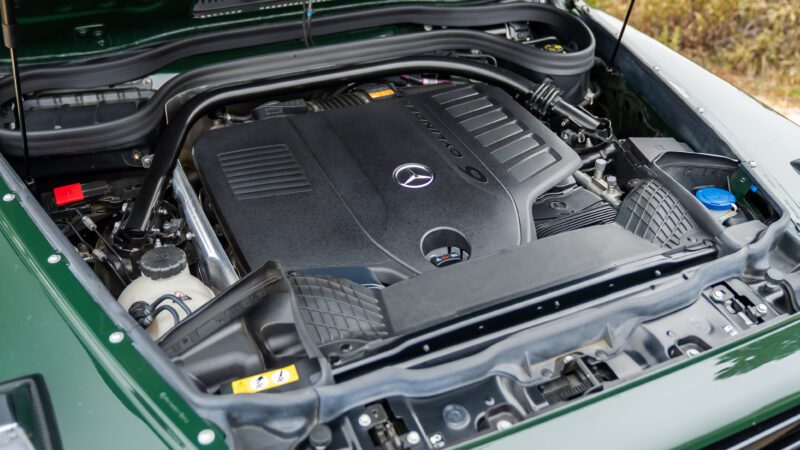
As impressive as this powertrain’s achievements are on paper, allowing a vehicle that weighs 5,534 pounds to still hit 60 mph in 5.3 seconds, it’s a great example of when more is less. The Geländewagen is defined by its ability to create a sense of occasion. Previously, this meant appreciating its boxy aesthetic as you approach, slamming its door, hearing its world-class latching sound, and listening out for its burbly engine note as it comes to life. That’s no longer true if you don’t shell out for the flagship G63.
Instead, what greets you is an engine note that’s quiet and uninspiring. It’s the noise you’d expect from an E-Class at less than half the price. Still, once you consider this truck’s $181,000 as-tested figure, its engine makes an otherwise expensive luxury vehicle feel decidedly less so.
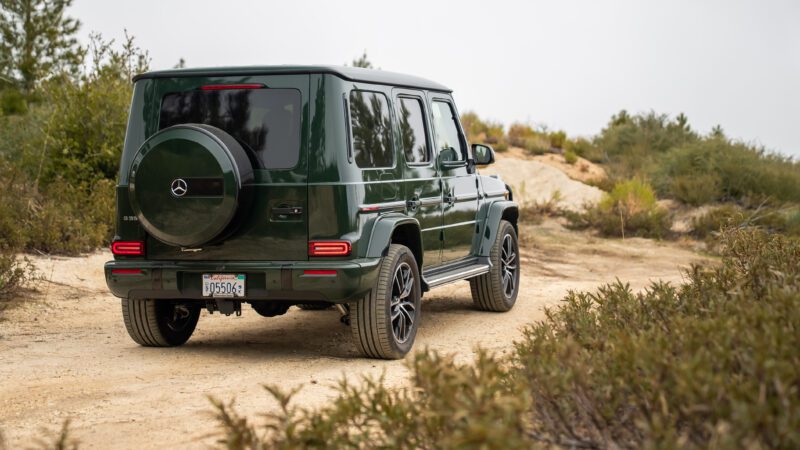
Thankfully, this new inline-six is willing to perform. It offers ample torque throughout its rev range, and because it relies on a mild-hybrid system, it’s responsive. It is almost entirely undetectable at highway speeds and has the benefit of increased fuel efficiency. The nine-speed auto is mated to shift both quickly and smoothly, while its standard brakes remain plenty powerful to consistently slow this tall and hefty SUV.
Like its predecessors, the Mercedes-Benz G550 remains a proper off-roader first. It still rides on a ladder frame, incorporates three locking differentials, and its transfer case sends 40 percent of its output to its front wheels and the remaining 60 percent to the pair in the rear. From a suspension standpoint, the G550 counts on double wishbones up front and a solid rear axle. It pairs springs with adaptive dampers in contrast to the G580’s plush air suspension setup.

A new Offroad Cockpit consolidates vital readouts, including incline data, into a single screen, while a forward-facing camera provides a clear view of the trail ahead.
The on-road refinement improvements introduced for this latest G-Class generation are immediately noticeable. The G550 soaks up road imperfections well without excessive body motions. While it lacks the active roll stabilization available for the G63, it can tackle bends confidently without considerable lean. It’s perfectly damped for cruising at highway speeds, and thanks to its extensive isolation, it creates an in-cabin experience that isn’t interrupted by unwanted road and wind noise.
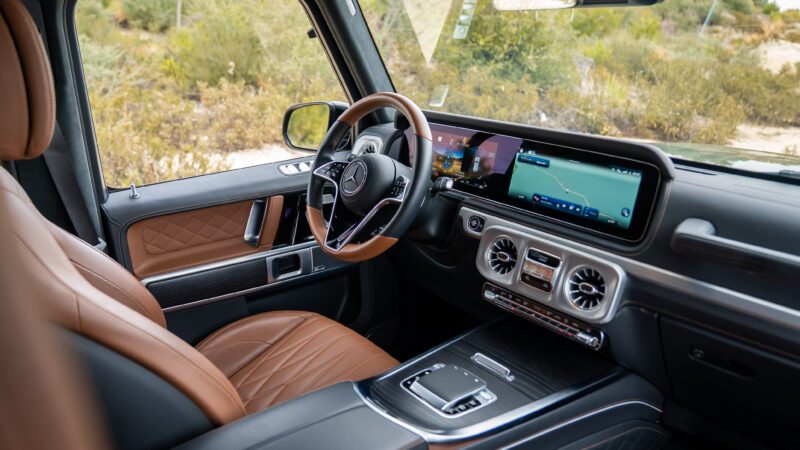
A significant contributing factor to this tester’s high as-tested price is its $13,250 Manufaktur Interior Package Plus. Aside from adorning the front row with a pair of Active Multicontour seats, this option covers this SUV’s cabin almost entirely with Nappa leather and extensive stitching. This tester takes the opportunity to cover its seats, door cards, and two-tone steering wheel in tan leather. This shade pairs nicely with its dark green exterior.
More importantly, this package goes a long way to making the Mercedes-Benz G550 feel every bit as expensive as it is. Practically every surface you interact with is covered in leather, and aside from the touch-sensitive buttons on its steering wheel, this interior incorporates as little plastic as possible. While its wheel controls may be cumbersome, you can still control core functions, such as this SUV’s climate control, through physical switches on the dashboard.
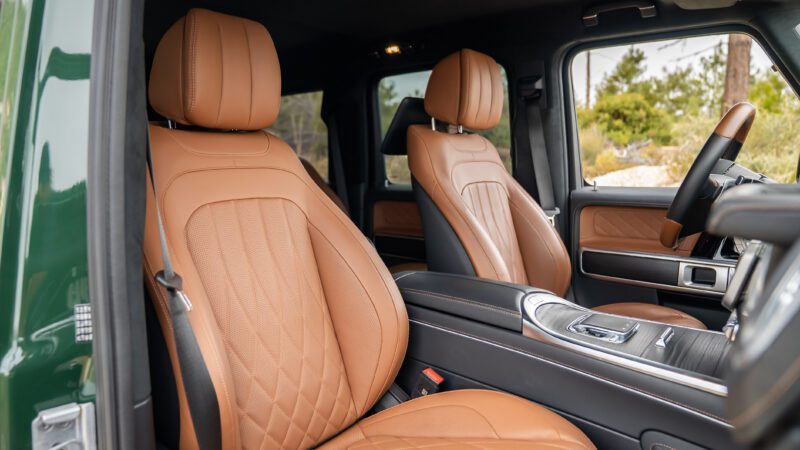
On the tech side, the G550 features twin 12.3-inch digital instrument clusters and infotainment screens, both running the latest version of its MBUX software. Not much has changed on this front, so the system will feel quite familiar if you’ve interacted with other Mercedes-Benz products introduced in recent years.
For 2025, the Mercedes-Benz G550 starts at $149,400. Factor in all of its optional extras, costing an as-tested $181,000. Although these figures represent a modest increase over the outgoing G550, it simultaneously places the “entry-level” Geländewagen within striking distance of its electrified twin. For context, earlier this year, the G580 I tester carried an as-tested price of $192,690 ($162,650 base price).

Yet, during my week with the G550, I couldn’t help but think about the G580. While I can’t yet speak for the new G63, the electric G-Class is impressive despite being a first-generation product. Given that you can no longer get a V8 engine in an SUV without an AMG badge in the rear, why not instead go all in with an off-roader that’s even more capable due to its clever use of its electric motors, better-riding thanks in part to the weight added by its battery pack, and developing 579 hp and 859 lb-ft, far quicker too?
The Geländewagen is undeniably an automotive icon. From its distinct aesthetic to its tall stature and its opulent yet sturdy cabin, its fans return because, in part, they know they’ll be met with a tweaked version of an experience that remains unique. However, by removing its much-loved rumbling engine note, the new G550 might be more impressive on paper than ever, but in practice, it takes one crucial step back.
Tags: Featured



